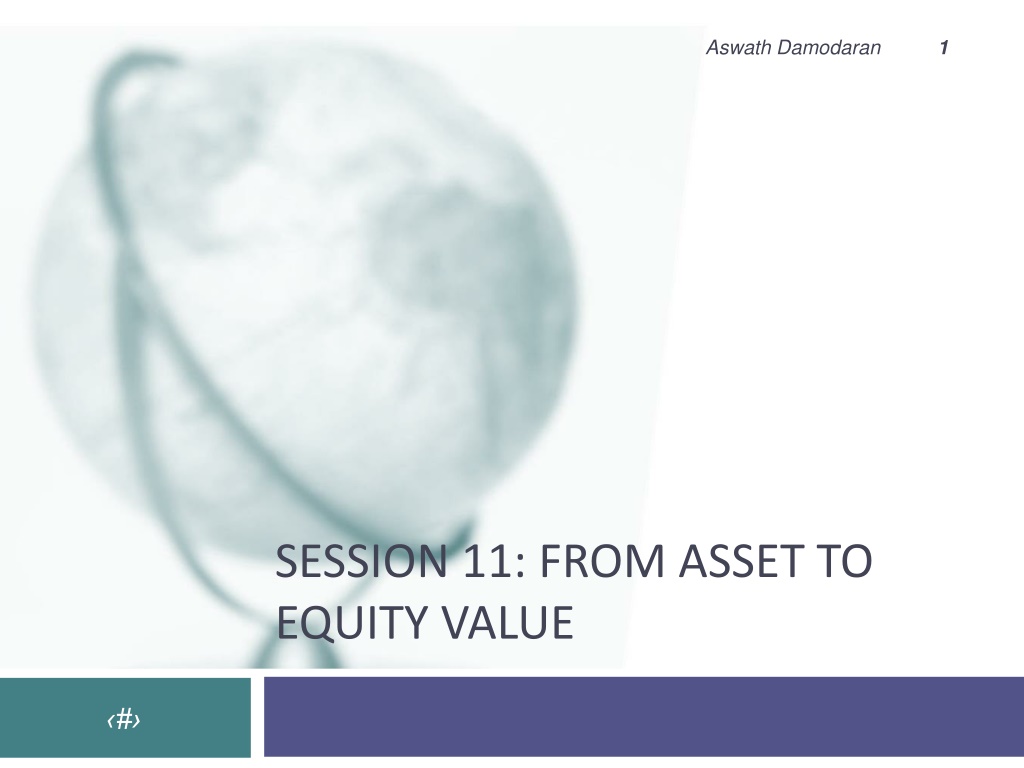
Asset, Equity Value, & Cash Valuation Insights
Explore insightful discussions and exercises on asset to equity value transition, cash valuation scenarios in various companies, market value of cash, handling holdings in other firms, and intrinsic valuation of cross holdings like Yahoo! Japan and Alibaba.
Download Presentation

Please find below an Image/Link to download the presentation.
The content on the website is provided AS IS for your information and personal use only. It may not be sold, licensed, or shared on other websites without obtaining consent from the author. If you encounter any issues during the download, it is possible that the publisher has removed the file from their server.
You are allowed to download the files provided on this website for personal or commercial use, subject to the condition that they are used lawfully. All files are the property of their respective owners.
The content on the website is provided AS IS for your information and personal use only. It may not be sold, licensed, or shared on other websites without obtaining consent from the author.
E N D
Presentation Transcript
Aswath Damodaran 1 SESSION 11: FROM ASSET TO EQUITY VALUE #
From Asset to Equity Value 2 Aswath Damodaran 2
1. The Value of Cash An Exercise in Cash Valuation Company A Company B Company C Enterprise Value Cash Return on Capital Cost of Capital Trades in $ 1 billion $ 100 mil 10% 10% US $ 1 billion $ 100 mil 5% 10% US $ 1 billion $ 100 mil 22% 12% Argentina In which of these companies is cash most likely to trade at face value, at a discount and at a premium? 3
Cash: Discount or Premium? Market Value of $ 1 in cash: Estimates obtained by regressing Enterprise Value against Cash Balances 1.4 1.2 1 0.8 0.6 0.4 0.2 0 Mature firms, Negative excess returns All firms High Growth firms, High Excess Returns 4
2. Dealing with Holdings in Other firms Holdings in other firms can be categorized into Minority passive holdings, in which case only the dividend from the holdings is shown in the balance sheet Minority active holdings, in which case the share of equity income is shown in the income statements Majority active holdings, in which case the financial statements are consolidated. 5
How to value holdings in other firms.. In a perfect world.. In a perfect world, we would strip the parent company from its subsidiaries and value each one separately. The value of the combined firm will be Value of parent company + Proportion of value of each subsidiary To do this right, you will need to be provided detailed information on each subsidiary to estimated cash flows and discount rates. 6
Yahoo! An intrinsic valuation of cross holdings In May 2014, Yahoo s core business in the US was struggling (with stagnant revenues & declining margins) but it had valuable minority holdings in Yahoo! Japan (35%) and Alibaba (22%). Yahoo! was trading at $33.76 in May 2014, just a few weeks prior to the IPO of Alibaba. The intrinsic valuations of Yahoo! Japan and Alibaba are based on their full financial statements. 7
With insufficient information, two compromise solutions The market value solution: When the subsidiaries are publicly traded, you could use their traded market capitalizations. The relative value solution: You can convert the book values of holdings that you have on the balance sheet by using the average price to book value ratio of the sector in which the subsidiaries operate. 8
3. Other Assets that have not been counted yet.. Unutilized assets: You can assess a market value for unutilized and uncounted assets and add them on to the value of the firm. No double counting: If you count the income from an asset in your cashflows, you cannot count the market value of the asset in your value. 9
An Uncounted Asset? Price tag: $200 million Aswath Damodaran 10 10
4. Be circumspect about defining debt for cost of capital purposes General Rule: Debt generally has the following characteristics: Commitment to make fixed payments in the future The fixed payments are tax deductible Failure to make the payments can lead to either default or loss of control of the firm to the party to whom payments are due. Definitely Debt All interest bearing liabilities, short term as well as long term All leases, operating as well as capital Definitely not debt Accounts payable or supplier credit May be debt, but only if legal obligations follow Unfunded pensions or health care obligations 11
But you should consider other potential liabilities when getting to equity value If you have under funded pension fund or health care plans, you should consider the under funding at this stage in getting to the value of equity. If you do so, you should not double count by also including a cash flow line item reflecting cash you would need to set aside to meet the unfunded obligation. You should not be counting these items as debt in your cost of capital calculations . If you have contingent liabilities - for example, a potential liability from a lawsuit that has not been decided - you should consider the expected value of these contingent liabilities Value of contingent liability = Probability that the liability will occur * Expected value of liability 12
